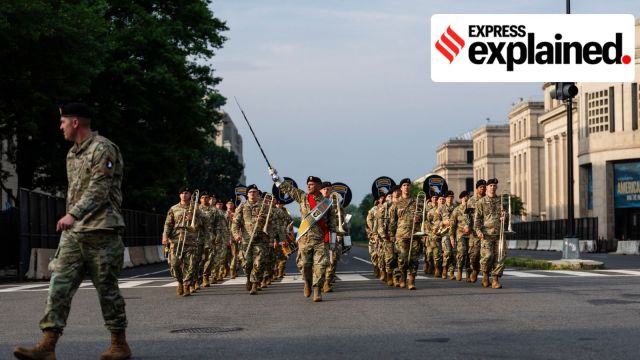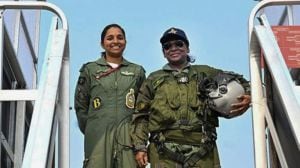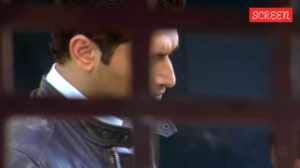US Army turns 250: How military parades became a symbol of national pride
The Army Day parade is the culmination of Trump’s eight-year-long fascination with the military parade.
 Members of the Air Assault Band of the 101st Airborne Division practice ahead of the U.S. Army’s 250th anniversary parade on the National Mall in Washington, on Friday, June 13, 2025. (Eric Lee/The New York Times)
Members of the Air Assault Band of the 101st Airborne Division practice ahead of the U.S. Army’s 250th anniversary parade on the National Mall in Washington, on Friday, June 13, 2025. (Eric Lee/The New York Times)
A massive military parade will be held in Washington on Saturday evening (June 14) to commemorate 250 years of the US Army. The date coincidentally also happens to be US President Donald Trump’s 79th birthday, as well as Flag Day.
According to the White House, June 14 marks the day “the sword and shield of our Republic were forged when the Second Continental Congress voted to establish what would later become the United States Army.”
The parade will be the first since the Victory Celebration of 1991 to welcome returning veterans of the Gulf War.
The event is estimated to cost between $25 million and $45 million, and feature over 6,000 soldiers, 128 army tanks, armoured personnel carriers and artillery, as well as an aerial display featuring 62 aircraft, according to an AP report. It would culminate the day-long festivities at Washington’s Lincoln Memorial, featuring NFL players and fitness competitions.
The timing of the parade is significant, even as the president showed his eagerness to deploy National Guard and Marine troops to suppress protests over immigration raids in Los Angeles over the past week.
The enduring legacy of the parade
Historical accounts have described strong displays of soldiers and weaponry and their role in asserting national pride.
Accounts dating to the Mesopotamian civilisation mention marching soldiers. Through the sacred Gate of Ishtar in Babylon, returning warrior kings would march into the city down a passage flanked by 60 giant lion statues on either side, with murals of the gods smiling upon them.
In the heyday of the Roman Empire, victorious generals would lead a procession into the capital, surrounded by frenzied crowds on all sides. The grand show of force displayed by an organised marching contingent of soldiers cemented legacies of triumph and near-mystical power in the minds of onlookers and beyond.
As empires crumbled and made way for nation-states, the tone of the military parade has endured. The rise of nationalism in Europe in the 19th century converted military parades into national symbols meant to capture the collective frenzy of a nation’s inhabitants into feelings of nationalism.
The Prussian army is said to have pioneered modern military parades. The notorious “goose-step” which would become a symbol of the Nazi army, as well as several popular formations seen today trace their origin to Prussia.
In India, a symbol of national pride and unity
During the British Raj, royal parades and processions were commonplace in India. They projected British power not only to Indians but to the rest of the world, especially competing European colonial powers. As India gained its independence, it retained many erstwhile British traditions, including the parade.
A military parade marked India’s first Republic Day in 1950. At the time, the country’s leaders wanted to commemorate the occasion as a day of national celebration. While the day marked India’s new constitution officially coming into effect, leaders saw it as a day of victory for the Indian state and its people – victory against colonial rule and the coming of a new, sovereign and strong republic. Thus, the military parade was chosen as an integral part of Republic Day celebrations.
The Republic Day parade began to include many non-military elements, such as the iconic tableaux, adding not only colour to the stoic military tone but also becoming symbols of India’s diverse culture. As tensions among Indian states endured over fears of cultural imposition and linguistic differences, the tableaux showcasing the best of several states came to become a means to celebrate India’s differences while representing a coherent national identity.
What Saturday’s parade will feature
The Army Day parade is the culmination of Trump’s eight-year-long fascination with the military parade. In 2017, after attending the Bastille Day festivities on French President Emmanuel Macron’s invitation, Trump described it as one of the most dazzling spectacles he had ever seen.
In the run-up to Saturday’s event, he has promised a grand display of patriotism. “It’s going to be an amazing day,” he said earlier this week. “We have tanks. We have planes. We have all sorts of things, and I think it’s going to be great. We’re going to celebrate our country for a change.”
The parade will feature different eras of the Army’s history, ranging from the Revolutionary War to the present day.
TROOPS: The parade will feature 6,169 soldiers. 150 troops in period costume will display important military events from the Battle of Lexington, which kicked off the Revolutionary War, to the present day. They will be followed by hundreds of troops in contemporary uniforms.
TANKS AND AIRCRAFT: 128 Army tanks, armoured personnel carriers and artillery, as well as 62 aircraft, will be featured. In keeping with the chronological theme, the parade will feature the first World War I Renault tank and the World War era aircraft, including two B-25 Mitchell bombers, four P-51 Mustang fighter aircraft and one C-47 Skytrain. As the procession makes its way into the modern day, the Army’s M1A2 Abrams tanks and troop carriers like the Joint Light Tactical Vehicle and Stryker combat vehicle would be featured. The parade will also feature High Mobility Artillery Rocket Systems (HIMARS) mobile rocket launchers.
The parade will culminate with a long air parade of UH-60 Black Hawk, AH-64 Apache and CH-47 Chinook helicopters flying overhead. The final section of marching troops would feature new recruits, new enlistees in training and military cadets, representing the future of the Army.





- 01
- 02
- 03
- 04
- 05
































